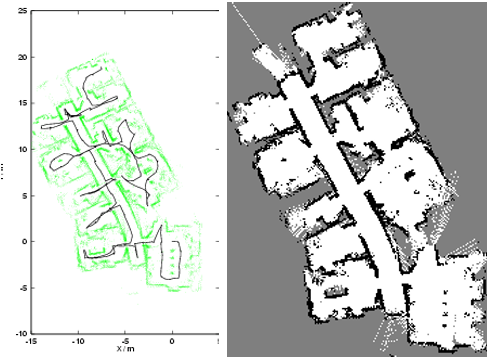




Did you find this useful? Give us your feedback



![Fig. 1. Raw sensor data from the Artificial Intelligence Lab, Freiburg, as in [6], showing the odometry trace and laser rangefinger readings.](/figures/fig-1-raw-sensor-data-from-the-artificial-intelligence-lab-nuy0b1il.png)





3 citations
...There are also other new methods for SLAM, for example, A genetic algorithm for SLAM[100] and A multigrid approach for accelerating relaxation-based SLAM[101]....
[...]
3 citations
...A genetic algorithm was developed to solve this problem, producing a global solution by searching the space of possible robot maps [5],...
[...]
3 citations
...Moreover, compared with Duckett’s[7] method, our approach is able to find the optimal solution much faster, because we used the EP for training the weight of the neural network and this means that search space of the EP is much smaller than the Duckett’s approach....
[...]
...Several studies have been performed to solve the robot’s SLAM problem using the computational intelligence technique which includes neural network [5], fuzzy[6], neuro-fuzzy, and genetic algorithm (GA) [7], but all have demerits....
[...]
...Our approach is robust for the system and sensor noise and can find the optimal solution more easily than Duckett [7]’s method, because the neural network is able to “learn” the relationship between the robot’s motion increment and the robot’s odometry error under consideration about the sensor uncertainty....
[...]
3 citations
3 citations
...Search in this large space for optimum solutions is very time consuming [5, 19]....
[...]
...PROPOSED ALGORITHM The problem of SLAM can be defined as an optimization in the space of all possible maps and robot trajectories [19]....
[...]
52,797 citations
32,573 citations
...GAs are a well-known search technique in which simplified, numerical forms of the biological processes of selection, inheritance and variation are used to improve the average fitness of the population through successive iterations [7]....
[...]
12,457 citations
...Genetic algorithms are particularly useful for solving environment modelling problems because they exploit the building block hypothesis, whereby better and better strings are constructed from the best partial solutions (i.e., schemata or building blocks) of previous generations [ 4 ]....
[...]
2,834 citations
2,358 citations
...[11] introduced a hybrid approach using a particle filter to track the pose of the robot, where each particle is associated with a set of Kalman filters estimating the position for each landmark....
[...]
A further possibility would be to combine the global search algorithm with a local optimization method, e. g., EKF [ 5 ], consistent pose estimation [ 10 ], relaxation [ 3 ], etc. A further possibility would be to investigate implementation of the algorithm on parallel processors, given the parallel nature of evolutionary computation. Future work should also include more detailed theoretical and empirical analysis of the problem and the algorithm required to solve it, e. g., with respect to the fitness criteria needed for different environments.